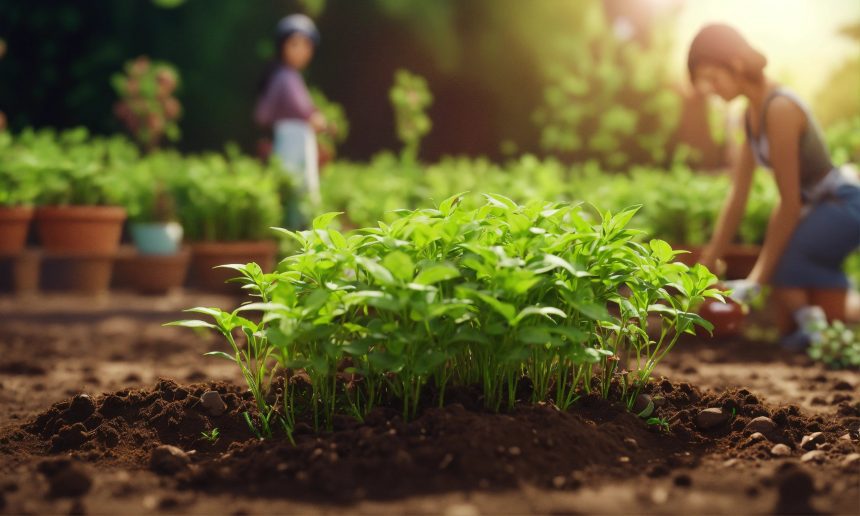I have always loved gardening. Even as a child, I enjoyed digging in the soil, planting seeds and watching beautiful flowers and tasty vegetables grow with just a little care and attention. Now as an adult homeowner, I have the space to truly pursue my passion for gardening and make my backyard a sanctuary filled with the fruits (and flowers!) of my labor. In this article, I will share my gardening journey, tips I’ve picked up along the way, my favorite plants to grow and the sheer joy gardening has brought me over the years.
How I Developed a Green Thumb
As a kid, I was always fascinated by the plants and flowers I saw. My grandmother had the most gorgeous rose bushes in her front yard. I loved smelling their sweet scent up close. She also grew tomatoes, zucchini, carrots, lettuce and all kinds of tasty vegetables. I have fond memories of snacking on fresh veggies right from her garden. When I visited, she put me to work—having me dig holes for new plantings, water established plants and pull nasty weeds. By teaching me the basics, my grandmother instilled in me a passion for gardening from a young age.
When my parents saw how much I enjoyed puttering around grandma’s garden, they gave me a small plot of my own in our backyard. It became my special project and I loved caring for my flowers and vegetables. As I got older, I expanded my gardens until I had lovely beds filled with peonies, irises, zinnias, marigolds, tomatoes, squash and berries. Gardening gave me such joy and a sense of accomplishment caring for living things and enjoying their beauty. Now I can’t imagine not having a backyard filled with gorgeous, lively plants I have carefully tended.
Preparing Garden Beds
When my husband and I bought our first house, the backyard was nothing but grass, but I saw potential. The first step in establishing my new garden was prepping the beds. I have clay soil that is hard for plants to grow in, so I added lots of compost and peat to improve drainage and nutrition. I outlined and edged my beds with bricks and garden borders to keep things neat and organized.
In my experience, raised garden beds are ideal for plant health. The soil loosens as beds mound up, allowing air to penetrate and excess moisture to drain away from roots. I built several raised beds from cedar planks secured at the corners. Cedar naturally resists decay and provides good insulation from temperature fluctuations. I filled them about 6 inches deep with a premium potting mix blended with compost for added nutrients. After adding soaker hoses for watering inside the beds, I was ready for planting!
What to Plant
Over the years, I have loved growing all sorts of flowers, herbs, vegetables and fruit plants. Here are some of my all-time favorites that I recommend to any gardener:
Flowers
- Peonies – With their lush, full blooms in shades of pink, red, white and yellow, peonies are stunning. They make gorgeous cut flowers and give a beautiful early summer show.
- Daylilies – Available in almost every color, daylilies are carefree plants that bloom from early summer into fall with long flower stalks and six-petaled blossoms. They multiply quickly to make lovely clumps.
- Iris – The blooms on iris plants are equally exotic. Ruffled shapes in royal purple, buttery yellow, creamy white and more make a vibrant statement in garden beds and borders.
Herbs
- Basil – We use lots of fresh basil for making pesto, seasoning dishes and topping pizzas. Several pots allow me to harvest all summer long. Sweet Genovese basil is my personal favorite.
- Chives – The grassy leaves of chives lend mild onion flavor to foods. Hardy plants produce pretty purple flowers. I love snipping chives to mix into dips, salads, soups, etc. A few plants go a long way.
- Oregano – Essential for Italian cooking, oregano thrives in a pot or garden bed with full sun and well-drained soil. I dry bunches upside down to preserve that wonderful zesty flavor through winter.
Vegetables
- Tomatoes – Sweet, juicy homegrown tomatoes are impossible to match from a store and so rewarding to pick from the vine. I opt for tried-and-true heirloom varieties like Brandywine, Cherokee Purple and Black Krim in addition to compact paste tomatoes like Roma and San Marzano for sauces.
- Zucchini – Prolific zucchini plants crank out tons of summer and winter squashes. I love sautéing the small, tender fruits with onion and herbs, shredding them into quick breads and using their bright flowers as edible garnishes.
- Carrots – These sweet, crunchy veggies do best in loose, rock-free soil. I sow seeds directly in garden beds, allowing the slender orange taproots room to swell. Fresh carrots are heavenly for snacking and add great texture, flavor and nutrients to dishes.
Fruit
- Strawberries – Nothing compares to the concentrated sweet-tart taste of vine-ripened strawberries. I grow them in containers since the fruits touch soil and can rot from excess ground moisture. Alpine varieties produce petite berries continuously all season rather than one big early flush.
- Blueberries – Requiring acidic soil, blueberry shrubs produce clusters of miniature deep blue spheres with a slightly dusty “bloom.” Blueberry plantings should have at least two varieties for best pollination. We enjoy them fresh, frozen, baked into muffins and pies and more.
- Raspberries – I train raspberry canes up and over a trellis, pinching back tops to encourage abundant fruiting side shoots. We enjoy an early crop of sweet red berries and then a heavier late summer harvest. I save some to crush and simmer into a delicious syrup.
Gardening Tools I Can’t Live Without
A green thumb truly relies on quality tools more than inborn skill. My gardening toolbox contains several must-have implements that assist me in planting, maintenance and harvesting from my flower and food gardens. Here is my handtool hall of fame:
Bypass Hand Pruners
Bypass pruners make clean cuts on stems up to 1/2-inch thick with a sharp blade that slices past a guard. I use them to clip spent blossoms, pinch and train plants, harvest fruits and herbs and selectively trim off damaged wood. Felco and Corona brands offer durable options. I keep a holster attached to my gardening belt for quick access.
Cultivator
A long-handled cultivator helps loosen and aerate soil, extract weeds, mix in fertilizers and neatly edge beds. The steel tines are equally effective breaking up different dirt consistencies. I prefer a 3-prong cultivator with a cushioned grip.
Hori-Hori Knife
This versatile gardening knife serves multiple functions. It’s rugged stainless steel blade has a semi-sharp edge for harvesting root crops like carrots and potatoes and a serrated edge to saw through soil and roots when weeding. The concave shape also makes an excellent scoop. Hori-hori knives come with a sheath for safety.
Bypass Loppers
Long-handled loppers build on hand pruner cutting action but give greater leverage and strength to snip thicker branches up to 1 1/2 inches diameter. Their long handles and gear or pulley mechanisms multiply applied force. I use bypass loppers to prune mature shrubs and maintain young fruit trees. Felco and Fiskars both make excellent choices.
Soft Tie Plant Ties
Securing plants to supports as they grow prevents damage and encourages proper shape. I prefer soft chenille stem ties rather than abrasive twist ties or inflexible wire. They gently conform to delicate stems with just enough flex and cushion. I use soft ties for tomatoes, climbing vines, espalier fruit trees and other plants needing support.
Battling Backyard Bullies
Even the most attentive gardener will inevitably encounter some insect and critter pests or plant diseases. An ecosystem in balance can withstand minor attacks, but left unchecked, damage can escalate. Through diligent observation, prompt action and integrated pest management (IPM) strategies, I effectively control the usual suspects without harsh chemicals.
For chewing pests like caterpillars, beetles and slugs/snails, I handpick off offenders and sometimes use organic Bacillus thuringiensis (BT) spray if they persist. For sucking insects like aphids, lygus bugs and spider mites, insecticidal soap or lightweight horticultural oil sprays suffocate them on contact while safeguarding beneficials. Floating row covers erected at planting now deter most pests from crops like brassicas and cucurbits so no pesticides are needed.
I inspect plants frequently for signs of fungal diseases and bacterial infections like oddly colored or spotted leaves, branch dieback, stunted growth, white crusty deposits or black mold. If I catch issues early before they spread, usually removing and destroying infected plant parts halts the disease. Good sanitation and airflow discourages foliar diseases. Resistant plant varieties also help avoid common problems like tomato blight, blackspot roses and more without spraying.
Bardening Friendly Insects
While some insects damage my garden plants, many more play helpful roles keeping pests in check, pollinating blossoms, aerating soil, recycling nutrients and indicating environmental health through their presence. I always take care to nurture these beneficial bugs.
Pollinators like flickering butterflies, buzzing bees, hummingbird moths and more carry pollen from flower to flower allowing fruits, vegetables and seeds to develop. I supply nectar-rich plants at different heights blooming all season—tithonia, calendula, catmint, asters, basil, borage, thyme, cosmos, coneflower—to feed diverse pollinating species. Water sources like a small pond or fountain provide needed hydration.
Natural pest predators include fiery lady beetles, lightning quick praying mantises, ambush spiders, carnivorous wasps and tiny parasitoid wasps. They feast on harmful caterpillars, scale, mites, whitefly, aphids and other plant-damaging prey. Seeing a balance of “good” bugs means my garden ecology is in sync. If pest outbreaks occur, I purposefully attract more beneficials by choosing less toxic control methods.
Gardening in Different Seasons
Gardening follows natural cycles through the year that dictate planning, plant selection and maintenance work. By tuning into seasonal rhythms, I work with nature to make the most of my garden instead of fighting it.
Here’s an overview of my gardening focus and typical chores by season:
Spring
Spring marks fresh beginnings as gardens awaken. I assess winter damage, prune shrubs/trees, clean up beds, start compost pile turning and overseed lawns during March-April as frosts end. Cool weather crops like lettuce, spinach, peas get direct sown or transplanted out once soil thaws and dries adequately. I pot up summer annuals and vegetables to harden off for planting after my zone’s average last frost date passes. April showers demand keeping up with weeding before they take over!
Summer
June-August bring heat, humidity, frequent watering/weeding and rapid growth. My flower gardens hit peak bloom with coreopsis, coneflowers, shrikem daisies, phlox and lilies alongside rambunctious annuals like zinnias, marigolds and cleomes. Edibles need consistent moisture. I monitor for pests like tomato hornworms and diseases. Deadheading fading blossoms, pinching back leggy plants and occasional selective pruning keeps growth robust into fall.
Fall
I welcome September-November’s cooler relief, marveling at foliage transforming into brilliant hues. Harvesting summer veggies continues even as I pull expired annuals and plant pansies, cabbage/kale, lettuce under hoops for extended cropping. Clearing beds, I incorporate organic material then direct sow cover crops to enrich soil over winter. I prep tools, store chemicals properly, drain hoses and blow out irrigation systems before freezing. Leaves make abundant mulch for insulating beds.
Winter
Though the garden slumbers beneath snow or mulch, December-February bring catalog planning and seed orders alongside forcing bulbs like hyacinths, amaryllis or paperwhites indoors. My garden journal records issues, successes and ideas during quiet months to guide next year’s designs. I check for rabbit/vole damage, deicing salt toxicity, excess snow load on shrubs and temperature swings cracking maple tree bark. Then I dream of spring’s awakening while amending soil awaiting nature’s yearly renewal!
The Joys and Benefits of Gardening
As you can see, I’m completely hooked on gardening and make the most of my backyard plot. Caring for my flowering landscape beds and edible garden brings me complete contentment along with numerous practical benefits:
Creative Satisfaction
I enjoy designing interesting garden bed shapes and arrangements mixing annuals, perennials, veggies and ornamental plants to create my ideal landscape. Seeing it come to life is incredibly fulfilling.
Quality Food
The fruits, vegetables and herbs from my garden taste noticeably better than store-bought while being chemical and preservative free. Produce harvested at peak ripeness offers amazing flavor and nutrition. We literally taste the abundance of summer and fall in so many dishes thanks to fresh-picked ingredients.
Stress Relief & Exercise
Pulling weeds, digging holes, hauling bags of soil and other physical gardening tasks release stress and tension while working muscles. I garden for at least 30-60 minutes daily to get my dose of cardio exercise and peaceful alone time. Afterwards I feel rejuvenated instead of exhausted.
Money Savings
With the soaring costs of groceries these days, growing my own makes economic sense. I calculate the value of edible yields from my garden at over $1,000 annually! Flowers end up costing next to nothing when grown from seed.
Outdoor Living Area
My garden offers a beautiful green setting to relax outdoors. I spend summer and fall mornings with coffee and a book, afternoon barbecues and evenings stargazing from comfortable patio chairs amidst gorgeous landscaping I created.
In closing
I wholeheartedly believe gardening enriches life on so many levels. I encourage everyone to start small by planting a few flower pots or dedicating a section of yard to vegetables you love eating. Let your garden grow with your passions! I guarantee nurturing plants will cultivate joy and satisfaction that overflows to benefit the rest of your life. Now if you’ll excuse me, it’s time to get my hands dirty!




